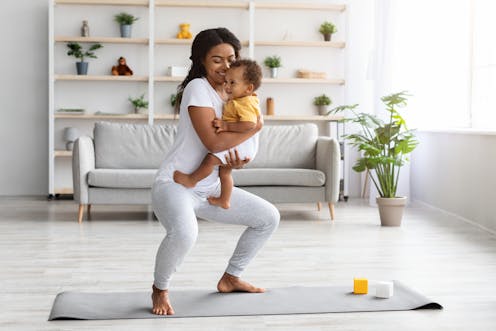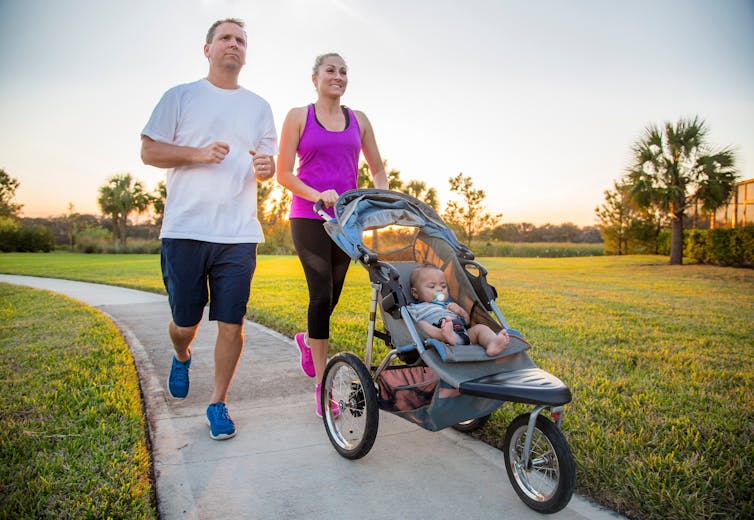
Returning to exercise after having a baby has many health benefits, including reducing symptoms of postpartum depression and improving fitness. But many women aren’t sure how to return to exercise safely after having a baby.
You can start preparing for your return to exercise during pregnancy. By exercising as long as it’s safe to do so, you can limit the amount of “deconditioning” (loss of fitness as a result of inactivity) the body undergoes – making it easier to get back to exercise after having a baby.
But even if you didn’t exercise very much during your pregnancy, it’s still possible to transition safely back into exercise after having your baby. The key is to progress gradually and listen to your body every step of the way.

This article is part of Quarter Life, a series about issues affecting those of us in our twenties and thirties. From the challenges of beginning a career and taking care of our mental health, to the excitement of starting a family, adopting a pet or just making friends as an adult. The articles in this series explore the questions and bring answers as we navigate this turbulent period of life.
You may be interested in:
Six reasons to take up yoga during pregnancy
Meeting a friend’s new baby? Here’s what – and what not – to do
Baby names: why we all choose the same ones
Those first few weeks
One of the first exercises you should do after having a baby is pelvic floor exercises. The pelvic floor helps maintain bowel and bladder function, supports the pelvic organs (bladder, bowel and uterus), and is important in facilitating sexual function and pleasure. During exercise, these muscles also tolerate the forces produced during exercise – those from the ground, transferred up the legs, and those produced internally in your abdomen.
Pelvic floor exercises can help prevent urinary incontinence, which affects around one in three women after having a baby. To strengthen the pelvic floor, tighten your muscles by imagining you’re trying to stop gas or the flow of urine. Release your muscles again after a second or two. That’s one repetition. Aim to do eight to 12 reps, with the goal of eventually holding each rep for ten seconds.
Core exercises, such as pelvic tilts or glute bridges, can also be reintroduced in the weeks after delivery. These help to recondition the abdominal wall muscles that have been stretched during pregnancy. Start with just a few repetitions of each exercise at first. You can also try doing body weight exercises such as squats and lunges.
Walking also has many health benefits, even in small doses, and is easy to get back into after giving birth. It’s safe to walk daily, just be sure not to do too much too soon. And avoid unnecessary strenuous activities in the weeks after giving birth, such as pushing a buggy up a steep hill. This is especially important if you’ve had a caesarean section, as your recovering muscles may not be ready for this strain yet.

Low-impact exercise
After a few weeks of pelvic floor and core training, you’ll probably want to progress to low-impact exercises – such as cycling on a static bike or power walking – in order to exert yourself more and reap even more health benefits of exercise. You’ll know you’re ready to progress if you haven’t experienced any issues with your pelvic floor (such as incontinence and vaginal heaviness) or had setbacks such as pain or infections.
If lochia – the normal loss of blood following childbirth – has ceased you could also try swimming or water aerobics, which are known to offer many health benefits. If you’ve already been doing body-weight exercises, consider adding light weights to progress your strength. This will also prepare your body to move on to more intense exercises.
Medium-impact exercise
Around six to 12 weeks after giving birth, when tissue is more or less healed, many women start running again.
Running is not only good for your mood and mental health, it can also fit easily into your new postpartum routine. However, leg pain affects around 80% of postpartum runners when they return. Gradually increasing the amount of running you do – perhaps using a walk-to-run programme – may help you avoid this.
Resistance training during this time can also be beneficial. Not only does it rebuild strength, it may also reduce the amount of bone-mineral density loss, which can happen due to breastfeeding. Importantly, bone-mineral density is usually restored in breastfeeding mothers after weaning the baby, but strength training may speed up this process.
High-impact exercise
There are still no official guidelines on returning to high-impact sports (such as gymnastics or rugby) postpartum. However, research shows that both heavy lifting and Crossfit are not harmful to pelvic floor health in women – as long as you progress carefully.
If you can tolerate medium-impact exercises without symptoms and have done so for a few weeks, you can probably transition into higher-impact exercises. Just make sure to progress gradually and adapt as needed. While there are no defined timeframes, research shows that, on average, professional power lifters return to Olympic lifting at 16 weeks postpartum. It is therefore likely that most women will be able to return to high-impact exercise somewhere between eight and 16 weeks.
Other considerations
It isn’t just the type or amount of exercise you need to think about after giving birth. Other factors, such as birth trauma, poor mental health and energy levels may delay your progress in returning to exercise. Fear of exercise can also get in the way of returning to exercise, potentially due to the lack of clear guidance informing women about how to return and the commonly experienced pelvic floor symptoms – such as leaking or vaginal heaviness. In such cases, it’s important to seek help from a medical professional.
Every woman’s body is different, meaning the time it takes to return to exercise will vary. You’ll know your body, and by listening to its limits and what feels right for you, you’ll be able to return to, and enjoy, exercise after having a baby.
Izzy Moore receives funding from the Economic and Social Research Council, Welsh Rugby Union, World Rugby and United Rugby Championship. She sits on the Rugby Players' Association Women's Welfare Advisory Group and the UK Young Academy.
Gráinne Donnelly is affiliated with The Active Pregnancy Foundation Charity by sitting on the specialist advisory board as a volunteer physiotherapist with subject matter expertise relevant to pregnancy and postpartum.
This article was originally published on The Conversation. Read the original article.







